Differing Totem Poles of Delicate Dreams and Realities
A visit to artists Rajkumar and Shantibai in the interiors of Chattisgarh was a stark contrast of lives and identities in a constant state of collision, and their artwork, a stark reminder of the residue we leave behind when worlds collide
Manoj Nair
The landscape from the airport at Raipur to the interiors of Bastar is a long road to nowhere. It is instilled with the fear common to the twentieth century, which is known to us as dread. I was on my way to the abode of artists Rajkumar and Shantibai, and was being taken there by a driver who was kindness personified. Dayalu (the kind), who lived in the city, seemed to carry the burden of being better off. He comes from a village not far away from where we were going and he was pleasantly surprised to find a few among him to be making it in the world outside as an artist. He says that he could never have imagined this, as he parks his car to drop me off at ‘Dialogue’ in Kopeweda, just three kilometres off the road in Kondagaon between Raipur and Jagdalpur. Kondagaon, as Wikipedia says, the source of all information that human kind doesn’t labour to find out about, is a municipality about 70 km from Jagdalpur city and is the headquarters of Kondagaon district in the Indian state of Chhattisgarh. It was surprising how in the time of demonetsation, the Rs. 1,000 and Rs. 500 notes that are no longer legal tender was very much in circulation. That was an eye opener to how far withdrawn the state and its subjects (not citizens) were away from each other. ‘Dialogue’ is a centre set up by artist Navjot Altaf, along with artists Rajkumar, Shantibai and Gessuram; it is also the studio of Rajkumar and Shantibai. They work under the shadow of the Mahua tree that overlooks the small and humble centre. Just like the Mahua tree that changes with seasons – blessed with leaves, fruits, and then, as if in anger, shorn off all leaves – the works of Rajkumar and Shantibai is proof of how the spirits in our art are stubbornly practical.
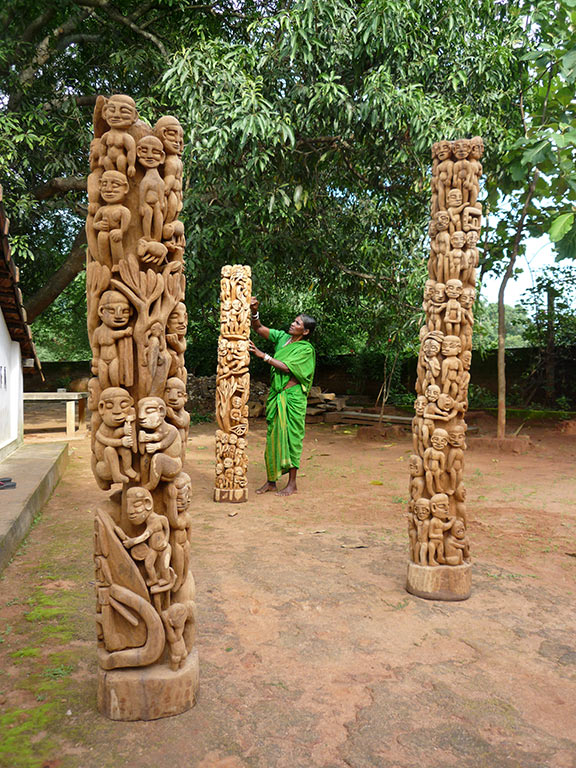
In a strife-torn region, these artists give us reliable guidance. Both of them have placed themselves at the forefront of articulating what a contemporary artist can be and at the extreme end of the spectrum of how a craftsman can transform through his practice. Rajkumar and Shantibai belong to a rare group of artisans who have broken away from their traditions of making artefacts for the marketplace and have, instead, taken the bold step to forecast and even predict the magnitude or method of our next predation, of what we are capable of doing to ourselves and to our neighbours. This is very much relevant in a year of medium, small and large deaths.

Rajkumar and Shantibai are from the conflict-ridden region of Bastar who have opted out of the easy way of catering to the craft market for bell metal, wood and terra cotta sculptures and figurines and chose to speak about their struggles as people caught between the state and those fighting against it and the aftermath. They had a show at a pristine place like the Guild Gallery in Alibaugh in Mumbai curated by Navjot Altaf, far away from the bindings of strife. Shantibai showed her paintings and wooden sculptures while Rajkumar had his own political sculptures and photographs on show.
‘We’re talking not about intellectual language, or a conceptual or aesthetic language, we’re talking about a reaction,’ says Rajkumar, as I struggle to put Rajkumar’s words spoken in a mix of Hindi and Halbi into English. When their works were shown in a gallery space, they met you on a different level – rather than the mental one, they engaged you on a physical level with a sense of violence that they live with every moment of their lives. One is with it or against it, and that triggers a dialogue.
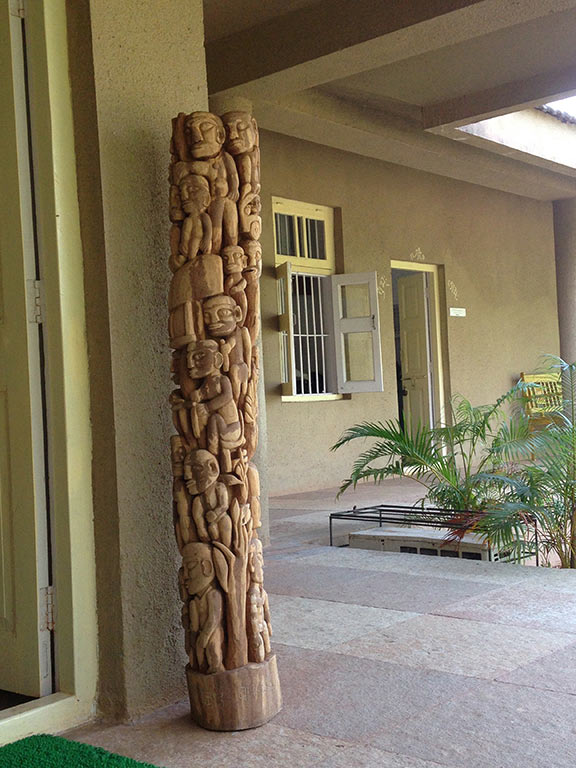
***
They take about three to four months to build their stories on a Maria Khamba. It involves a long laborious process of procuring the wood that has fallen on its own or has been cut by the forest department for ‘development’. Once the logs are brought in after proper sealing and paperwork, the work begins. ‘I can tell stories with these poles, I can educate people, I can use my art as an excuse to access people and travel the world – those things suddenly became very exciting to me, and that’s when I decided that this was what I wanted to do,’ says a very unassuming Rajkumar (that he says is also recorded in his diary), as we sit under the shade of the Mahua tree.
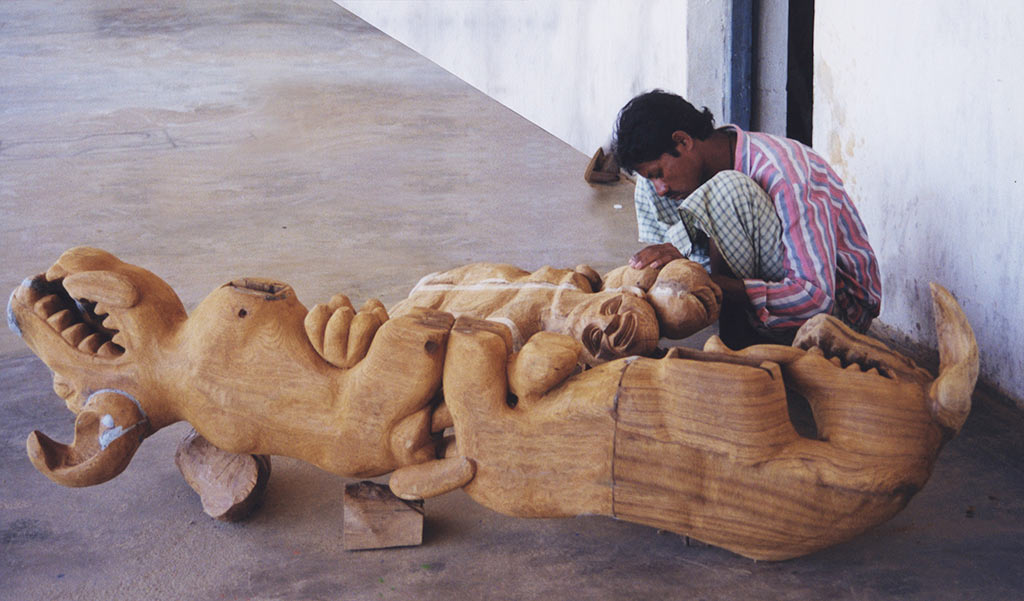
You can see those thoughts being brought to fruition in his khambas. One is about the environmental degradation caused by the tripper lorries and mining activities; the other is about how education can flow like a river from the forehead of a person willing to share his knowledge; the third is about the crossfire he and his folks are caught between. ‘This bombing, shooting, human beings and brothers killing each other, this makes me very sad and melancholic. On top of my artwork, I have shown a collection of canons, guns, pistols, bombs, and so on. From whichever party the government might be, they should find a solution to this problem and give justice to people in the affected areas,’ Rajkumar says.
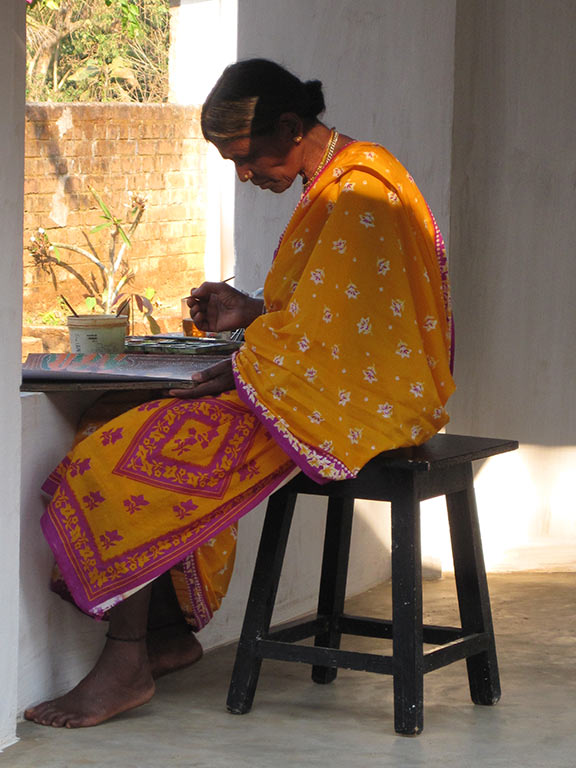
Both Rajkumar and Shantibai have taken time off from work when I visited them. Rajkumar is getting ready to reap his harvest of rice, which he says is a way of life that is being completely eroded by multinationals. And then he breaks into a story which is recorded in his diary and has been etched into his relief sculptures. It’s about Himanshu Kumar, one of the activists in the Dantewada area who fought against the ‘occupation’ of land that belongs to the tribals by the State. The relief work shows his house being burned down by the police. Most of Shantibai’s works, both sculptures and drawings, is propounded by the festival processions and other celebrations along with every mundane activity in the village. Yet, she writes in her diary: ‘During their search for Maoists, the police came to the village looking for them. This is Sonia’s home. She is washing vessels. When the villagers saw the police, they got scared and ran towards the forest. As Sonia was at home, they got into her house. One of the policemen went inside and raped Sonia, while two policemen were guarding the entrance. Sonia’s parents were beseeching the police and requesting them to let go of Sonia, but to no avail. After a while, the police left leaving Sonia like a goat.’
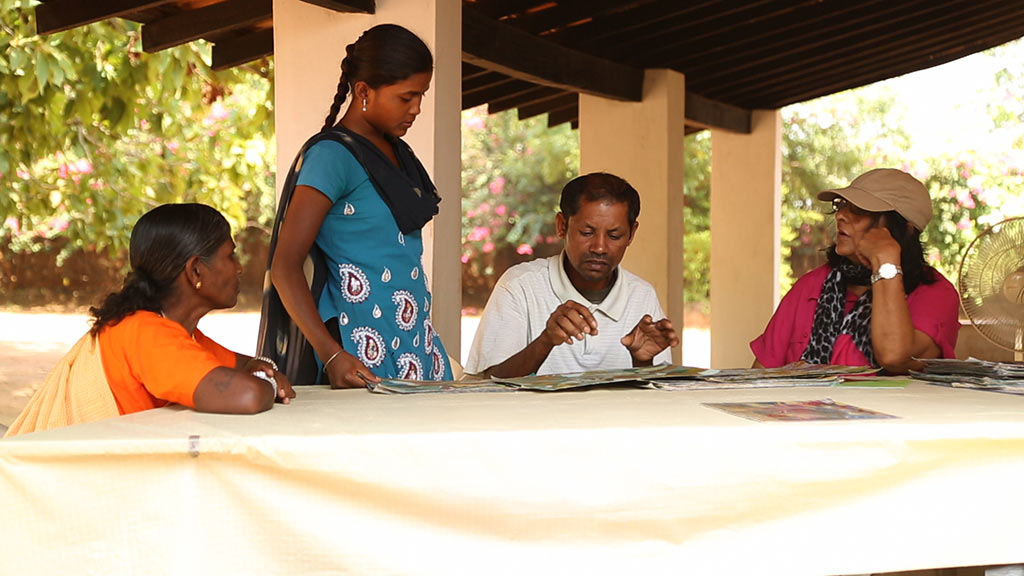
And she goes on writing about the incident and describes how Sonia and her father went to the police station to lodge a complaint. The police laughed at them and told them to go home; else they would rape her again. When Himanshu Kumar went and took up the case with the police they assuaged him, only to burn his house later. This story is depicted in one of the poles by Rajkumar.

Both of their works as artists, not artisans, have inspired many others to become contemporary artists and pose questions as serious as ‘what is contemporary.’ ‘It’s physically and emotionally exhausting work,’ says Shantibai. Her works are an affirmation of the reveries that Bastar is known for. But they are tinged with an ink of sadness thrown upon her community by modernity. ‘I think one has to be pretty tenacious and pretty dedicated,’ Shantibai says. ‘This work is not about me – it’s about the people and the issues I cover,’ she says in her fragmented Hindi. She is shy. One wonders why. And then, as an afterthought, when one looks at her works again, one realises she has seen terrible things, including death, destruction and hardship. Her friends and colleagues have been killed. Rajkumar wonders if he can go further with his art practice. Money, in the age of demonetisation in Bastar, is still an issue. It will catch up with time. His worries are more universal, though. Gun control. ‘As an artist I think that the representatives of various countries should sit together and discuss this and take a decision to ban the production of weapons and use of guns. Slowly all the weapons and guns should be collected and placed in a museum,’ he repeats what he has written. He lives in an ideal world. Like one of the episodes in Bastar’s favourite folklore, he is expecting the God, the saviour, to come down like a spider on a thread to save his lot. Till then, they hope to weave a web of their works, as contemporary as can be.
Share